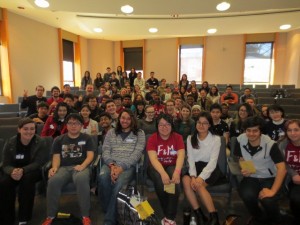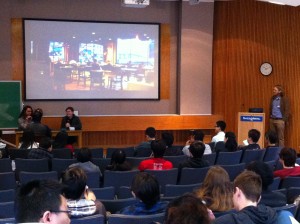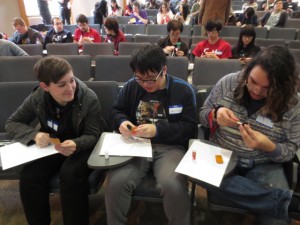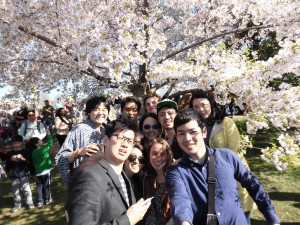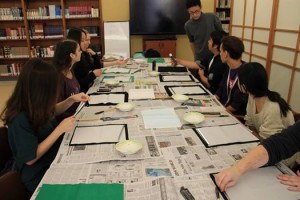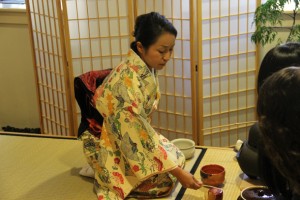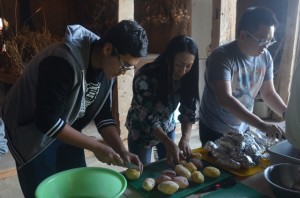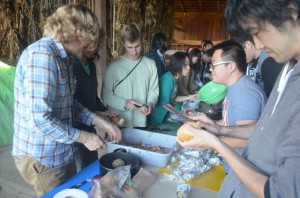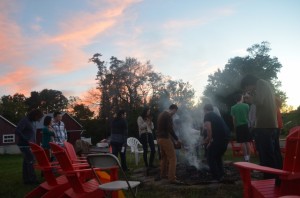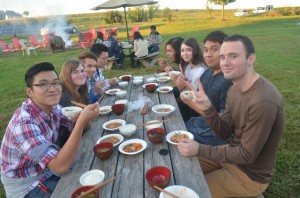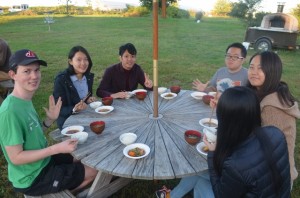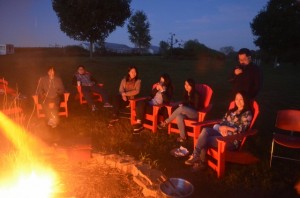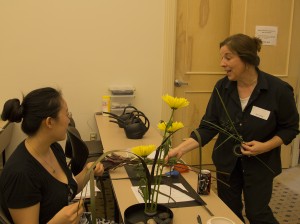The Cherry Blossom Festival
Shodo Demonstration by AIU Student
Sado Demonstration
Ikebana Series by Harrisburg International Ikebana Chapter
The Dickinson College Library and East Asian Studies Department hosted weekly ikebana demonstrations led by members of the Harrisburg International Ikebana Chapter.
J-Table at Dickinson farm
The study abroad reflections on Akita International University
Angel Acosta ‘15
The first time I went to Japan was last summer with a Dickinson program, Seismic Japan, where we studied not only the geological conditions that make Japan prone to earthquakes (and other natural disasters), but also the influence that natural disasters has had, and still has, on the Japanese culture and people.
I later went on to study abroad at Akita International University (AIU) in Akita for one year, one of two Japanese programs offered at Dickinson. While studying at AIU I joined the Kanto (竿燈) club, a 200-year old tradition in Akita where performers balance long, 50kg bamboo poles with paper lanterns attached at the top on their bodies. The festival, and the Kanto pole, actually represents a prayer for a good rice harvest in Akita, and is one of the biggest attractions in the Tohoku region. I was given the opportunity to be part of the festival when I joined the club, and it was one the best experiences I could ever ask for. I also joined the volleyball club and participated in tournaments throughout Akita.
At AIU I lived in a dorm, and my roommate was Japanese which gave me the opportunity to make more Japanese friends and helped me to further develop my Japanese speaking ability. Being able to use the language everyday made my experience in Japan much more meaningful. I took various Japanese courses, and was able to take a seminar with Japanese students on Japanese society. My favorite academic experience in that class was being able to travel around Akita and interview various elderly people to get their perspective on living in the countryside and their opinions on the decreasing birthrate and aging population in Japan. I also took traditional art classes such as calligraphy.
Being in Japan for one year helped me grow as I learned more about myself, and about what makes me happy. I was able to find what I was passionate about, which is invaluable and something that I would never trade for the world.
Ikebana Program October 2, 2013
On October 2, 2013, a small Ikebana workshop was conducted by Ellen Kelly, a member of Harrisburg Chapter, Ikebana International.
Ellen Kelly lived in Japan for over 5 years and fell in love with Ikebana. She was excited to share this part of Japanese culture with the students.
Students were taught about the origins of Ikebana and were guided through creating their own pieces.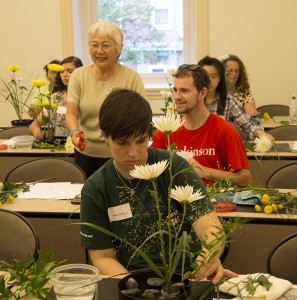
Funding for the workshop was generously provided by the department of East Asian studies, and the Luce Foundation.
Ikebana
Ikebana (lit. “flowers kept alive”) originated in sixth-century Japan as an expression of the beauty of nature; originally, Buddhist priests created the artful arrangements as offerings to the spirits of the dead. By the mid-15th century, ikebana was officially recognized in Japan as a high-art form, but it would be two more centuries before the merchant classes were permitted to practice it. Today, more than 2,000 schools of ikebana are registered with the Japanese government; Anna Nakada is a master of the ichiyo (“one leaf”) school, which takes into account the environment in which the arrangement will be displayed and the personal expression of the arranger.
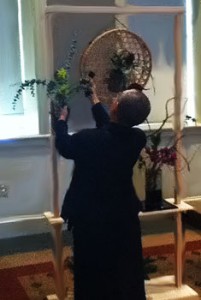
Ikebana Master Anna Nakada arranges flowers during a demonstration highlighting an ancient form of Japanese art. The flowers and branches she used were culled from the Dickinson campus.
Working in the Stern Center Great Room before a live audience, Nakada created several arrangements, using natural materials she’d gathered on campus with help from Randall Nenninger, manager of grounds and landscape services; Arborist Mike Shaffer; and Master Gardener Anne Dailey. Her two-hour demonstration, sponsored by the Department of East Asian Studies, was accompanied by an Waidner-Spahr Library exhibition of arrangements created by members of the Harrisburg chapter of Ikebana International. Nakada also fashioned a special arrangement to be included in a current exhibition at The Trout Gallery titled The Floating World: Ukiyo Prints From the Lauren Rogers Museum of Art.
As she created her ephemeral sculptures, Nakada explained that each piece in the arrangements represented an element of nature. She also spoke about the role of asymmetry in Japanese art; the proper composition of color, depth and height; the interplay between tradition and personal expression; and the discipline it takes to draw out expressions of nature that are as economically eloquent as nature itself.
“Ikebana is about selection,” she said of the painstaking process. “You have the whole world before you, and you select from it. Then you select, select and select again.”
Learning and Fun Through Film
Each semester Japanese films are
shown with English subtitles open to all students at Dickinson. Many of these films have won film awards and are highly regarded for their story lines and cinematography. Current films include:
- Norwegian Wood
- All About Lily Chou-Chou
- Nobody Knows
